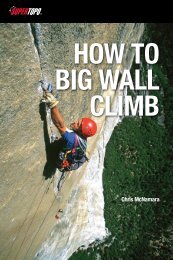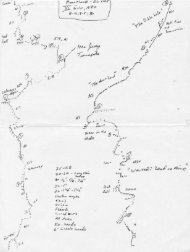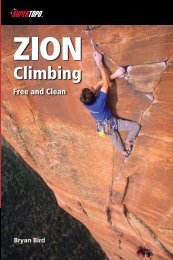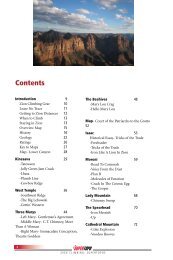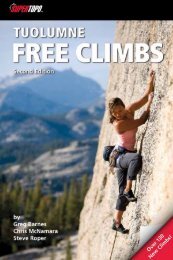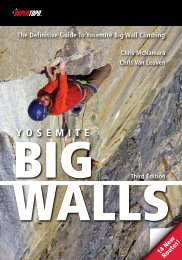Create successful ePaper yourself
Turn your PDF publications into a flip-book with our unique Google optimized e-Paper software.
The Nose<br />
VI 5.13+ or 5.9 C1 or 5.8 C2<br />
EL CAPITAN<br />
Long, sustained and flawless; the Nose may be the<br />
best rock climb in the world; it is certainly the best<br />
known. At 5.9 C1 this route is technically easy but<br />
don’t be fooled. The Nose, like all El Cap routes is huge<br />
exposed and terrifying.<br />
First ascent history<br />
After missing a chance to make the first ascent of<br />
Half Dome, Warren Harding knew there was only<br />
one other accomplishment that could surpass it—the<br />
first ascent of El Capitan. Because no technical rock<br />
climb of this scale had ever been attempted, Harding<br />
employed expedition tactics of using supplied camps<br />
linked by fixed ropes. In addition, the Park Service<br />
mandated that the climbers use fixed ropes so that a<br />
rescue would not be necessary. On July 4, 1957, six<br />
days after the first ascent of Half Dome, Harding and<br />
his team began their historic journey.<br />
After reaching Sickle Ledge in three days, the<br />
team pulled off two wild pendulums and faced the<br />
next obstacle, a series of 300-foot long, 2–3" wide<br />
cracks. Standard pitons that large did not exist, but<br />
Harding had come prepared. He had four enameled<br />
stove legs that Frank Tarver had scrounged from a<br />
Berkeley dump. Leapfrogging the 9" monsters up the<br />
continuously wide cracks, the team made it to<br />
within 100 feet of Dolt Tower before descending.<br />
The climb was a huge tourist attraction, and<br />
traffic became so tangled that the Park Service<br />
ordered a halt to the project until fall. Even under<br />
the best of circumstances climbers were viewed as a<br />
nuisance by the Park Service—“Somewhere between<br />
hippies and bears,” noted Wayne Merry, a member<br />
of Harding’s team. Despite the lack of warm feelings<br />
for the project, the Park Service lifted the ban as<br />
promised and Harding’s team pushed up to Dolt<br />
Tower before descending for the winter, leaving fixed<br />
ropes attached to the wall. Fixed ropes reduced the<br />
fright of being on such a colossal wall, but because<br />
they were made of manila and left swaying in the<br />
wind for months on end, the ropes presented a<br />
danger in themselves. Steve Roper describes a close<br />
call: “Wally Reed had just begun prusiking up a<br />
section of rope when suddenly he plummeted back<br />
onto a ledge. The rope had broken. Luckily the ledge<br />
was a fair-sized one and he didn’t roll off.”<br />
In May 1958, Harding<br />
and the team reached the Boot<br />
Flake, a feature that mysteriously<br />
floats on the wall with no visible means of attachment.<br />
Each pin placement caused the whole feature to groan<br />
and expand. On top of the boot, seeking the next crack<br />
system, Harding unleashed the wildest pendulum ever<br />
done, now renowned as the King Swing.<br />
By fall the route was pushed up to Camp IV, and<br />
both climbers and the Park Service wanted to wrap<br />
things up. Harding had been the leader from the<br />
start, and as problems arose and partners bailed, it<br />
was his determination that kept the project alive. Of<br />
the eight climbers who contributed to the first<br />
ascent, only Harding was involved for the duration.<br />
On November 1, 1958, the team, now consisting<br />
of Harding, Merry, Rich Calderwood and George<br />
Whitmore, prusiked to their high point at 1,900 feet<br />
and launched their summit campaign. The Great<br />
Roof, although appearing from the ground to be the<br />
crux of the route, was easily dispatched, and the<br />
climbers moved steadily up to Camp VI. At this<br />
point Calderwood suddenly dropped out, leaving<br />
Whitmore to move loads and Harding and Merry to<br />
swing leads up the spectacular upper dihedrals.<br />
After enduring a storm on November 10, they<br />
reached a small ledge 180 feet below the summit. Above<br />
them loomed a blank and overhanging wall. At 6 p.m.<br />
the next day Whitmore came up the fixed ropes, which<br />
now spanned 2,800 feet of the wall, and delivered a fresh<br />
supply of bolts to Harding. What followed was described<br />
by Steve Roper in Camp 4 as “the most famous single<br />
episode in Yosemite’s illustrious climbing history.”<br />
For 14 hours, from dusk till dawn, Harding<br />
endured the unimaginable pain of hand drilling 28<br />
bolts in a row by headlamp. At 6 a.m. he stood<br />
exhausted but triumphant on the summit, greeted by<br />
hordes of friends and media who created a huge<br />
commotion unlike that prompted by any previous<br />
climb. Scaling El Capitan had required 45 days of<br />
climbing over 18 months and had consumed 125 bolts.<br />
The triumph shook both the climbing and non-climbing<br />
worlds and would change big wall climbing forever.<br />
The term “impossible climb” would never again be<br />
used as easily. Within a few years the rush was on to<br />
climb in Yosemite.<br />
Aid<br />
A = aid using hammer<br />
C = hammerless aid<br />
Mandatory free<br />
A5/C5<br />
A4/C4<br />
A3/C3<br />
A2/C2<br />
Pitch<br />
1 2 3 4 5 6 7 8 9 10 11 12 13 14 15 16 17 18 19 20 21 22 23 24 25 26 27 28 29 30 31<br />
C<br />
A1/C1 C C C C C C C C C C C C C C C C C C C C C C C C C C C C<br />
5.8-5.9 • •<br />
≤5.7 • • • • • • • • •<br />
COPYRIGHT © 2000 SUPERTOPO LLC. ALL RIGHTS RESERVED. DUPLICATION PROHIBITED.






